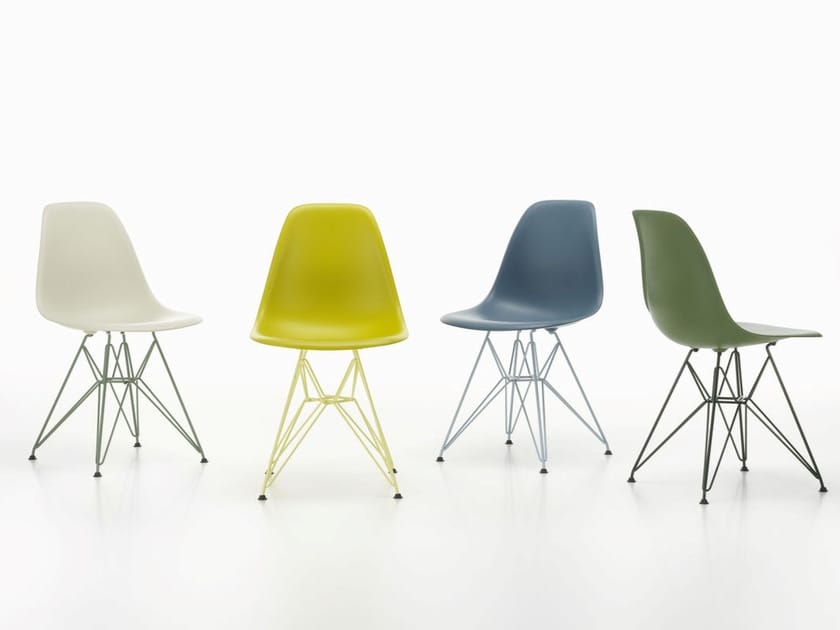


















































The so-called Eiffel Tower base of the DSR chair (Dining Height Side Chair Rod Base), an intricate and graceful construction made of steel wire, combines light, elegant forms with structural strength. The organically shaped plastic seat shell is available in various colours and upholstery options, allowing this distinctive classic by Charles and Ray Eames to be adapted to a wide range of individual needs and preferences.
Material description
- Seat shell: dyed-through, recycled polypropylene, 100% recyclable. All models are available with a seat cushion (screwed to the seat shell) or full upholstery. The fully upholstered version has moulded polyurethane foam padding covered in fabric, attached to the shell with a welted edge. Different shell and upholstery colours and various bases provide a multitude of possible combinations.
- Options: the Eames Plastic Chair is available as a visitor chair, dining chair, rocking chair, swivel chair or in stacking versions and with ganging brackets for row seating. Beam-mounted shells are suited for use in waiting areas.
- Base: non-stacking four-legged wire base with cross struts. The powder-coated version is suitable for outdoor use. (DSR = Dining Height Side Chair Rod Base)
- Note: special additives retard the fading of colours due to UV radiation. However, if the chair is exposed to sunlight for prolonged periods, the colour may change over time. We recommend limited exposure to sunlight.
From January 2024 the shells of the Eames Plastic Chairs from Vitra are now made of recycled post-consumer plastic. These chairs are known as Eames Plastic Chairs RE. The recycling material stems from Germany's 'Yellow Bag' (Gelber Sack) collection of household waste, which primarily consists of used packaging. Utilising this recyclate instead of conventional plastic generates fewer climate-damaging emissions and significantly reduces energy consumption.
Due to the composition of the recycled materials, the different colour versions of the seat shells are interspersed with tiny specks of pigment.
'Getting the most of the best to the greatest number of people for the least': with these words, Charles and Ray Eames described one of their main goals as furniture designers. None of their other designs come as close to achieving this ideal as the Plastic Chairs. For years, the designer couple explored the fundamental idea of a one-piece seat shell moulded to fit the contours of the human body. After experiments with plywood and sheet aluminium in the 1940s produce unsatisfactory results, their search for alternative materials led them to glass-fibre reinforced polyester resin.
The Eameses recognised and fully exploited the advantages of the material: mouldability, rigidity, pleasant tactile qualities, suitability for industrial manufacturing methods. With this material, which was previously unknown in the furniture industry, they successfully developed the shell designs for serial production. After their debut at the 'Low-Cost Furniture Design' competition organised by the Museum of Modern Art in 1948, the Plastic Armchair (A-shell) and Plastic Side Chair (S-shell) were launched on the market in 1950 as the very first mass-produced plastic chairs in the history of furniture.
The Eames Plastic Chairs also introduced a new furniture typology that has since become widespread: the multifunctional chair whose shell can be joined with a variety of different bases to serve diverse purposes. As early as 1950, Charles and Ray Eames presented a series of bases that enabled various sitting positions. An especially striking model is the so-called Eiffel Tower base – an intricate and graceful design made of steel wire that inimitably combines light, elegant forms with structural strength.
Today Vitra manufactures the comfortable seat shells of the Eames Plastic Chairs in polypropylene, while those of the Eames Fiberglass Chairs are produced in glass-fibre reinforced polyester resin. There is also a wide choice of bases and shell colours, along with upholstery options for some models. This allows customers to specify countless different combinations and to use the chairs in the widest range of settings – from dining rooms, living rooms and home offices to office workspaces and conference rooms; from restaurants and cafés to break rooms and cafeterias; from waiting areas and auditoriums to terraces and gardens.
In 2016, Vitra added roughly 20 mm to the base height of the Eames Plastic Chairs DSX, DAX, DSR, DAR, DSW and DAW while adapting the seat geometry accordingly.



















































































































































































